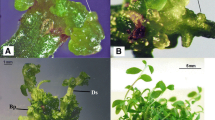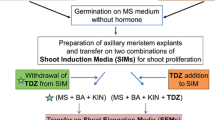Summary
Germination of tamarind seeds in medium containing thidiazuron (TDZ) resulted in induction of nodular protrusions in and around the cotyledonary node meristem. The structures developed radially in well-defined circles and subsequently spread towards the cotyledonary bridge and also in the proximal part of the hypocotyl. The structures developed into shoots on transfer to medium devoid of growth regulators. Histological studies revealed that the protrusions initiated from the nodal meristem and extended to the non-meristematic region between the two meristems and also in the proximal part of the hypocotyl in seedlings germinated in 9.08 μM TDZ. Newly formed cell layers and less-differentiated meristematic protrusions were also seen. With the increase in the distance from the meristem, the buds were less differentiated; in the proximal part of the hypocotyl only the multiple layers of meristematic cells were noted. With extension of the period of incubation, the TDZ-induced meristematic activity extended laterally in circles towards the neighboring region. The radial spread of the meristematic activity from the center of the nodal meristem was also evident at 18.16 μM TDZ. From the pattern of the morphogenic development and the histological studies it may be hypothesized that in tamarind, TDZ influences the existing meristems specifically. Subsequently de novo organogenesis is triggered in the neighboring cells.
Similar content being viewed by others
References
Distabanjong, K.; Geneve, R. L. Multiple shoot formation from cotyledonary node segments of Eastern redbut. Plant Cell Tiss. Organ Cult. 47:247–254; 1997.
Huetteman, C. A.; Preece, J. E. Thidiazuron: a potent cytokinin for woody plant tissue culture. Plant Cell Tiss. Organ Cult. 33:105–119; 1993.
Jaiwal, P. K.; Gulati, A. In vitro high frequency plant regeneration of a tree legume Tamarindus indica (L.). Plant Cell Rep. 10:569–573; 1991.
Kanyand, M.; Peterson, C. M.; Prakash, C. S. The differentiation of emergences into adventitious shoots in peanut, Arachis hypogaea (L.). Plant Sci. 126:87–95; 1997.
Lu, C. The use of thidiazuron in tissue culture. In Vitro Cell. Dev. Biol. Plant 29:92–96; 1993.
Malik, K. A.; Saxena, P. K. Regeneration in Phaseolus vulgaris L.: high frequency induction of direct shoot formation in intact seedlings by N6-benzylaminopurine and thidiazuron. Planta 186:384–389; 1992a.
Malik, K. A.; Saxena, P. K. Somatic embryogenesis and shoot regeneration from intact seedlings of Phaseolus acutifolius A., P. aureus (L.) Wilezek, P. coccineus L., and P. wrightii L. Plant Cell Rep. 11:163–168; 1992b.
Mascarenhas, A. F.; Nair, S.; Kulkarni, V. M.; Agrawal, D. C.; Khuspe, S. S.; Mehta, L. J. Tamarind, In: Bonga, J. M.; Durzan, D. J., eds. Cell and tissue culture in forestry, vol. 3. Case histories: gymnosperms, angiosperms and palms. Dordrecht: Martinus Nijhoff Publishers; 1987:316–325.
Mehta, U. J. Tissue culture studies in tamarind (Tamarindus indica L.), a leguminous tree species. Ph.D. thesis, University of Pune, Pune; 2001.
Mehta, U. J.; Barretto, S. M.; Hazra, S. Effect of thidiazuron on germinating tamarind seedlings. In Vitro Cell. Dev. Biol. Plant 40:279–283; 2004.
Mehta, U. J.; Krishnamurthy, K. V.; Hazra, S. Regeneration of plants via adventitious bud formation from mature zygotic embryo axis of tamarind (Tamarindus indica L.). Curr. Sci. 78:1231–1234; 2000.
Murashige, T.; Skoog, F. A revised medium for rapid growth and bioassays with tobacco tissue cultures. Physiol. Plant. 15:473–497; 1962.
Murthy, B. N. S.; Murch, S. J.; Saxena, P. K. Thidiazuron induced somatic embryogenesis in intact seedlings of peanut (Arachis hypogaea): endogenous growth regulator levels and significance of cotyledons. Physiol. Plant. 94:268–276; 1995.
Murthy, B. N. S.; Murch, S. J.; Saxena, P. K. Thidiazuron: a potent regulator of in vitro plant morphogenesis. In Vitro Cell. Dev. Biol. Plant 34:267–275; 1998.
Saxena, P. K.; Malik, K. A.; Gill, R. Induction by thidiazuron of somatic embryogenesis in intact seedlings of peanut. Planta 187:421–424; 1992.
Sharma, A. K.; Sharma, A. Chromosome techniques—theory and practice. London: Butterworths: 1980.
Sonia; Jaiwal, P. K.; Gulati, A.; Dahiya, S. Direct organogenesis in hypoeotyl cultures of Tamarindus indica. Biol. Plant. 41:331–337; 1998.
Victor, J. M. R.; Murch, S. J.; Krishna Raj, S.; Saxena, P. K. Somatic embryogenesis and organogenesis in peanut: the role of thidiazuron and N6-benzylaminopurine in the induction of plant morphogenesis. Plant Growth Regul. 28:9–15; 1999.
Author information
Authors and Affiliations
Corresponding author
Rights and permissions
About this article
Cite this article
Mehta, U.J., Sahasrabudhe, N. & Hazra, S. Thidiazuron-induced morphogenesis in tamarind seedlings. In Vitro Cell.Dev.Biol.-Plant 41, 240–243 (2005). https://doi.org/10.1079/IVP2004611
Received:
Accepted:
Issue Date:
DOI: https://doi.org/10.1079/IVP2004611




